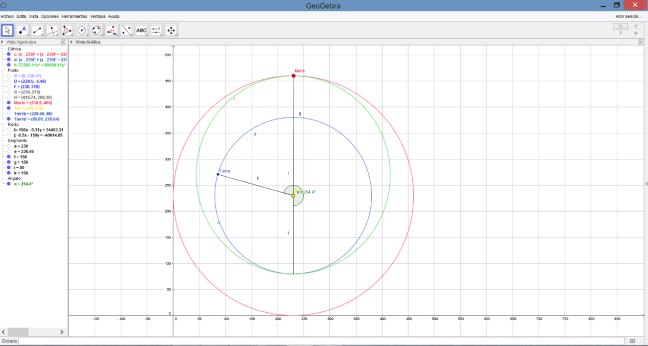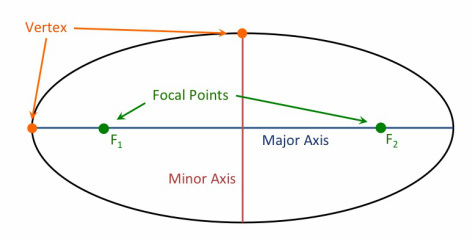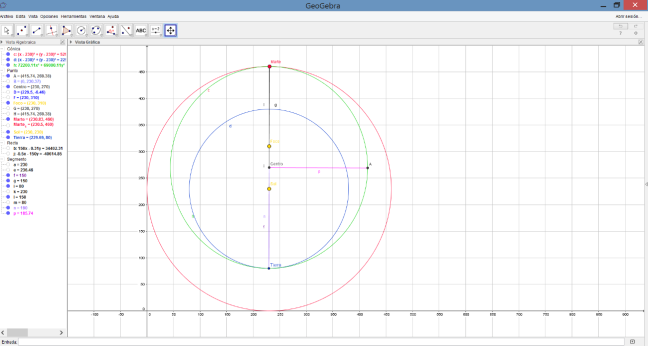As aforementioned, this blog also aims to show the applications of maths in other disciplines. This time we will talk about space – in particular about Mars. We all know that the Red Planet is a present target for mankind. There will certainly be a trip to Mars before 2030. But how far is this planet from us? How long would it take? Which would be the medium velocity of the rocket? We can answer all these questions with simple calculus.
The main question is: what trajectory should the rocket follow? The easy answer is «a straight line». But this is not feasible. It would require an enormous amount of energy because the rocket would tend to follow an elipse due to Sun’s gravity. Therefore we have to take advantage of this gravity. This is what Hohmann’s trajectory does. It was designed by the engineer and mathematician Walter Hohmann in 1925. By applying it, the travel wouldn’t be the shortest one, but it would be the one using less energy. It would only use fuel in two occasions: when leaving Earth’s orbit and when entering Mars’ orbit. The rest of the time it would follow en elipse around the Sun.
To start our maths, we will consider that the orbits of Earth and Mars around the sun are circular, and that they have a constant velocity. But in fact this is not true, as stated by Kepler’s three laws of planetary motion:
- The orbit of a planet is an ellipse with the Sun at one of the two foci.
- A line segment joining a planet and the Sun sweeps out equal areas during equal intervals of time.
- The square of the orbital period of a planet is proportional to the cube of the semi-major axis of its orbit.
Another term we have to take into consideration is the conjunction. This means the Sun, Mars and Earth are aligned with the Sun inbetween. Our rocket needs this position to get to Mars:

Therefore, where has to be Mars when the rocket is thrown? To investigate so, first we will calculate the angular velocity (ω) of each planet. It is calculated by dividing the angle (ϕ) by the time. We just need to know how long does it take for the Earth and for Mars to go all around the Sun (365 and 687 days respectively):
ω Earth = 360° / 365 days = 0,986°/day
ω Mars = 360° / 687 days = 0,524°/day
We can see that Mars’ angular velocity is higher. Now we will calculate the linear velocity (v) of both planets. It is done by dividing the space (x) by the time (t). We need to know the distance with each planet with the Sun (the radium) so that we can calulate the perimeter (x). The distance between the Earth and the Sun is 149.600.000 km and between Mars and the Sun it is 227.900.000 km. We multiply the diameter by π and hence:
v Tierra = (149.600.000 * 2 * π) / (365 * 24 * 3600) = = 29,8 km/s
v Marte = (227.900.000 * 2 * π) / = (365 * 24 * 3600) = 24,1 km/s
This is que trajectory our rocket must follow:

The blue circle represents the orbit of Earth, the red one represents the orbit of Mars, the yellow point is the Sun, the blue one is the Earth and the red one is Mars. The green ellipse represents the trajectory of the rocket. Here we can see when does the rocket need an impulse (when changing the orbit) and hence the use of fuel:

But we can no longer consider that the trajectory followed by the rocket is circular. Therefore, we will have to use Keplers’ laws, as it is an ellipse with the Sun as the focus. Remember that the third law stated that the square of the orbital period (T) of a planet is proportional to the cube of the semi-major axis of its orbit (a). We can write it by:
T2 / a3 = k
where k is a proportional constant. It is the same constant for all the planets that orbit around the same star. So we need to calculate the value of k in our Solar System, as it also includes our rocket. We will use the Earth and the units will be UA instead of kilometers (1 UA = distance Earth-Sun = 149.600.000 km) and years instead of days. Therefore:
12 / 13 = 1
and hence k = 1 in the Solar Sistem. For so, we can say that T2 = a3. For our rocket, a equals the major axis of the ellipse. It is calculed by adding the distances Earth-Sun and Mars-Sun and dividing by 2. The distance between Mars and the Sun in UA is:
227.900.000 / 149.600.000 = 1,524 UA
Thus:
a = (1 + 1,524) / 2 = 1,262 UA
T2 = a3
T2 = 1,2523
T2 = 2,009916728
T = 1,4177153
but to get to Mars, the rocket only travels through half the ellipse:
1,4177153 : 2 = 0,70885 years
0,70885 years = 8,5 months = 258 days
Now we ask ourselves, where should Mars be when the rocket is launched so that after 258 days it will be precisely in front of (with the Sun inbetween) where the Earth was when the rocket was launched? It is completely necessary, as the Red Planet and Mars must coincide.
To do so we divide the number of days the rocket spends to get to Mars by how many days this planet needs to go all around the Sun, and we multiply it by 360°:
360 * (258 / 687) = 135,7°
So when the rocket is launched Mars has to be at 180 – 135,7 = 44,3° on the right of the Earth.

And where will the Earth be when the rocket arrives on Mars? We make the same opperation:
360 * (258 / 365) = 254,4°
Hence this will be its position:

Before we continue, we should review the parts of an ellipse:
- Major axis: the longer radium (segment from the center)
- Minor axis: the shorter radium (segment from the center)
- Focis: two points in the major axis which are equidistant from the center point. The sum of the distances from any point P on the ellipse to those two foci is constant and equal to the major axis.

Now we have to find out the medium velocity of our rocket when travelling around the Sun (without taking into account the impulse when leaving the orbit of the Earth). We will do so by dividing the distance by the time. But we just know the time (258 days), so we will calculate the distance with the perimeter of the ellipse. Actually with half of the perimeter.
P = 2pi * sqrt((r*r + s*s) / 2)
where r is the major axis and s is the minor axis. This is not an exact formula, because to calculate the exact value of the perimeter we would need an infinite number of calculus.
We know the value of the major axis (the average of 149.600.000 km y 227.900.000 km = 188.750.000 km), but not of the minor axis. However, we do know that the Sun is one of the focal points of the ellipse (as stated by Kepler’s laws) and that in any point of the ellipse the sum of the distances to the two foci is constant and equal to the major axis.

In the representation we can appreciate the two focal points (the Sun and a point which is 1 UA from Mars’ orbit), the center of the ellipse, the major axis (purple), which mesurates 1,262 UA (the distance between the two focus is 2,524 – 2 = 0,524; 0,524 : 2 = 0,262) and the minor axis (pink), whose value is unknown. But the sum of the segments Sun – A and Foci – A must be equal to the major axis (1UA + 1,524 UA = 2,524 UA).

The segment Sun – A must be equal to 1,262 UA (2,524 UA : 2). The distance Sun – center of the ellipse is:
(2,524 – 2*1) / 2 = (2,524 – 2) / 2 = 0,524 / 2 = 0,262 UA
We apply Pythagoras theorem (s is the semi-minor aixs):
1,2622 = s2 + 0,2622
1,5926 = s2 + 0,0686
s2 = 1,5926 – 0,0686
s2 = 1,524
s = 1,234 UA
s = 184.645.169,72 km
Now we apply the formula for the perimeter of the ellipse:
P = 2pi * sqrt(r*r + s*s)
P = 2pi * sqrt(1,262*1,262 + 1,234*1,234)
P = 2pi * sqrt(1,5926 + 1,5227)
P = 2pi * sqrt(3,11530 / 2)
P = 2pi * 1,55765
P = 2pi * 1,248
P = 7,8417 UA
But the rocket only travels through half the ellipse, which is 7,8417: 2 = 3,921 UA = 586.563.204,927 km. Therefore, it will have a medium velocity of:
v = x / t
v = 586.563.204 km / 258*24*3600 s = 26,31 km
Lastly, we will calculate how many days have to go by so that a conjuction takes places (this is the necessary condition for the lauch of the rocket). The difference of the angular velocities is:
ω Earth – ω Mars = 360° / 365 days – 360° / 687 days = 360° (1 / 365 – 2 / 687)
To find out the number of days between two conjuctions, we divide 360° by the difference of the angular velocities:
360° / 360° * (1/365 – 1/687) = (365*687) / (687-365) = 778,74 days
Once all the calculus are completes, we can conclude that:
- The rocket must be launched when Mars is positioned 44,3° on the right of Earth.
- It will take the rocket 258 to get to Mars and it will have a medium velocity of 26,31 km/s. It will travel through 586.563.204 km.
- When the rocket gets to Mars, the Earth will have travelled 254,4°.
- The necessary conditions for a Hohmanns’ transference take place every 778 days.















